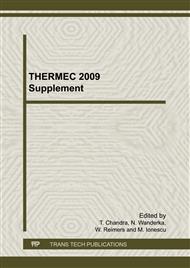p.539
p.545
p.551
p.556
p.562
p.568
p.574
p.580
p.586
Crystallization Behavior and Thermal Stability of Two-Glassy Phase ZR-Based Bulk Metallic Glasses
Abstract:
Based on the thermodynamic calculation, two phase separated Zr-based BMGs (Zr63.8Ni16.2Cu15Al5 and Zr66Cu15.3Ni8.7Al10) which developed by the authors previous study were selected for investigating their crystallization behavior and thermal stabilities by means of differential scanning calorimetry (DSC), and X-ray diffractometry. The results show that the Zr66Cu15.3Ni8.7Al10 amorphous alloy exhibits higher GFA than the Zr63.8Ni16.2Cu15Al5 amorphous alloy. But the Zr63.8Ni16.2Cu15Al5 amorphous alloy presents higher activation energy of crystallization (227 kJ/mole and 188 kJ/mole for Zr63.8Ni16.2Cu15Al5 and Zr66Cu15.3Ni8.7Al10 BMGs, respectively). However, Zr66Cu15.3Ni8.7Al10 amorphous alloy contains less atomic percentage of Cu and Ni elements (with positive heat of mixing) may result in forming less volume phase separation as well less interface area between these separated amorphous phase. Overall, the Zr66Cu15.3Ni8.7Al10 amorphous alloy exhibits longer incubation time at higher annealing temperature in comparison with the Zr63.8Ni16.2Cu15Al5 amorphous alloy, suggesting that the amorphous alloy which contains fewer amounts of Cu and Ni elements would have better thermal stability.
Info:
Periodical:
Pages:
562-567
Citation:
Online since:
January 2010
Authors:
Price:
Сopyright:
© 2010 Trans Tech Publications Ltd. All Rights Reserved
Share:
Citation:


